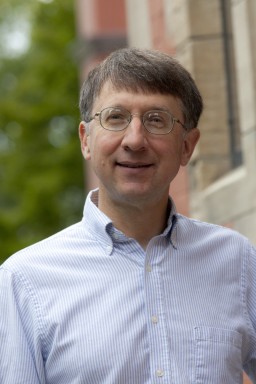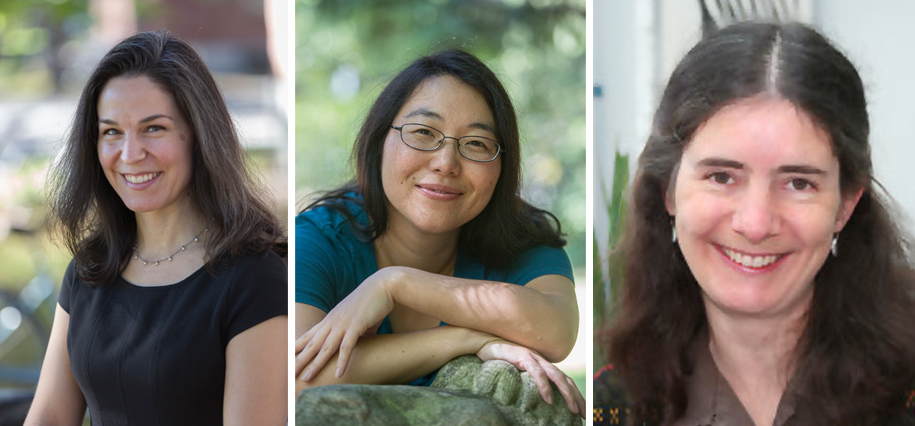With New Grant, Bowdoin Physicist Plans High-Energy Research Year

In the four years that the Simons Foundation has been awarding fellowships to theoretical physicists to support their sabbatical research, it has only given one such grant to a physicist at a liberal arts college. Stephen Naculich, professor of physics at Bowdoin, became that first awardee this year, joining a list of professors who work at such universities as Harvard, Cornell and McGill.
The grant will support a year of research for Naculich at the University of Michigan in Ann Arbor, where he’s received an invitation to join a group of scientists working in his area of elementary particle physics. He anticipates that being at the university — where he’ll interact with many faculty, post-docs and graduate students, and attend colloquiums and research talks — will lead to productive outcomes for him.
“I’ll be jumping in and immersing myself in a research world full time,” Naculich said. “It’ll give me ideas and projects for years to come….That is the key thing for someone like me at a place like Bowdoin. My research is really helped if I can be working with people at other institutions.”
Next year, Naculich plans to continue his research into “the properties of scattering amplitudes in gauge theories and gravity.” What this means is that Naculich calculates the probability of different outcomes that could occur when elementary particles, such as quarks and gluons, interact with one another. These days, he is working on a novel way of calculating those probabilities (which physicists refer to as amplitudes). These methods could potentially aid in understanding and interpreting data from experiments at particle accelerators, such as the Large Hadron Collider.
“The whole point is to try to understand what is going on at the level of the fundamental laws of physics, actually to discover the fundamental laws of physics and what kinds of particles exist,” Naculich said. “To do that, one considers different possible theories, and then tries to calculate what outcomes each theory predicts. Then one compares these predictions with the actual results of the experiments to see if any of them match.”
When Naculich explains his research to nonscientists, he does so in a careful, linear way. He starts by talking about a major tool in his field — particle accelerators. Particle accelerators bang particles, such as protons, together at very high speeds, approaching the speed of light. In that process, they convert the kinetic energy of the colliding particles into the rest energy of new particles. In effect, new particles are created in the collision — potentially Z bosons, top quarks, Higgs bosons, etc. “Different outcomes happen with different probabilities, all governed by quantum mechanics, which says we don’t know what’s going to happen, we can only predict the probabilities, ” Naculich said.
For half a century, physicists relied on Feynman diagrams to calculate these probabilities. American physicist Richard Feynman invented the diagrams in the 1940s to represent the behavior of particles. “We all love Feynman’s diagrams but it turns out they’re hard to use, particularly if the process involves many particles,” Naculich explained.
Yet, despite the cumbersome nature of Feynman diagrams, they have at times produced simple answers, presenting a clue to physicists that there might be a simpler way to do the calculations. Indeed, in the past two decades, Feynman diagrams have been improved upon, with scientists discovering new ways to calculate amplitudes that are “completely unexpected,” Naculich says.
It turns out the simple solution lies in “hidden symmetries.” Naculich says scientists can use hidden symmetries to flush out probabilities, somewhat like being able to predict what the left side of a person’s face looks like based on the right side.
Just in the past 18 months, several physicists working in Canada have found a new formula to calculate amplitudes “that seems to come out of thin air,” Naculich said. Yet, their formula so far only works for particles without mass.
However, Naculich says he’s been able to extend this new formula to amplitudes where some particles have mass. He’ll continue this line of research next year, but is quick to add that anything is possible in a field where change happens so rapidly. “I have no idea what I’m going to be doing next year because we tend to follow the clues where they lead,” he said. “And there’s no way to predict how they will go.”



